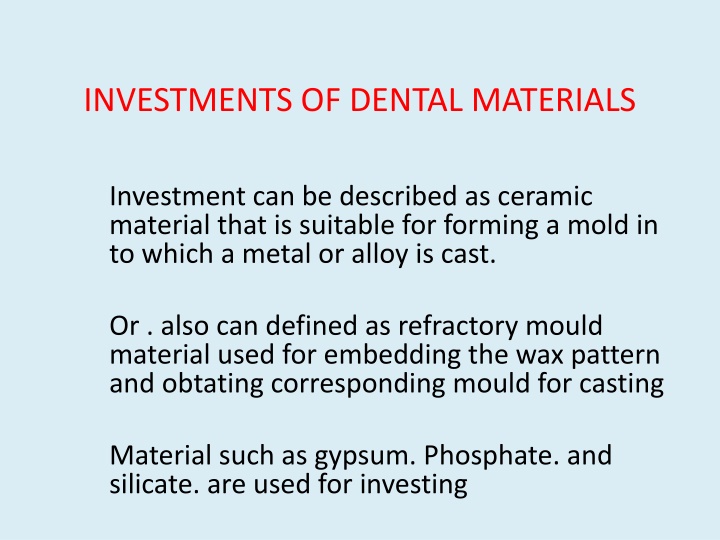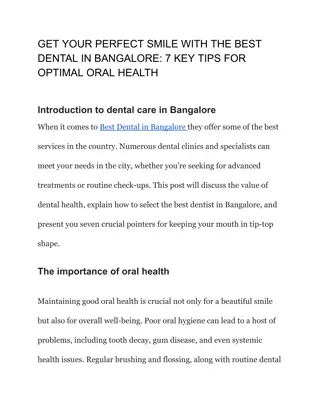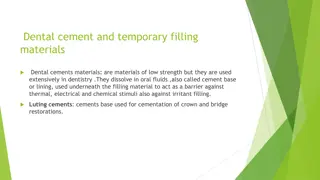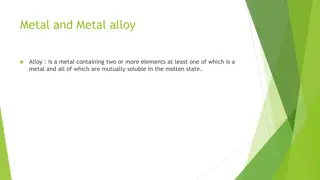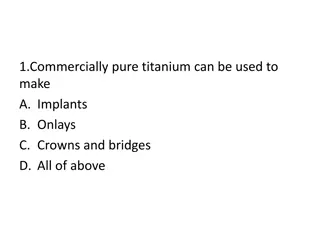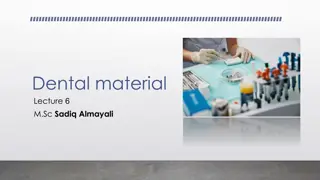Investments of Dental Materials
Dental investments are ceramic materials used to create molds for casting metal alloys in dentistry. These investments must accurately reproduce wax patterns, have suitable setting times, withstand high temperatures, and exhibit controlled expansion. Components include refractory materials, binder materials, and chemical modifiers. Common types include gypsum-bonded investments with specific properties for dental applications.
Download Presentation

Please find below an Image/Link to download the presentation.
The content on the website is provided AS IS for your information and personal use only. It may not be sold, licensed, or shared on other websites without obtaining consent from the author.If you encounter any issues during the download, it is possible that the publisher has removed the file from their server.
You are allowed to download the files provided on this website for personal or commercial use, subject to the condition that they are used lawfully. All files are the property of their respective owners.
The content on the website is provided AS IS for your information and personal use only. It may not be sold, licensed, or shared on other websites without obtaining consent from the author.
E N D
Presentation Transcript
INVESTMENTS OF DENTAL MATERIALS Investment can be described as ceramic material that is suitable for forming a mold in to which a metal or alloy is cast. Or . also can defined as refractory mould material used for embedding the wax pattern and obtating corresponding mould for casting Material such as gypsum. Phosphate. and silicate. are used for investing
Investing means capturing all the wax pattern in a solid material which capable of maintaining accurate details during burnout procedure casting of metal alloy. The investment material is available as two component system. Powder and liquid( water) Mixed before investing the wax pattern.
Ideal Requirement of an investment material It should be reproducing the shape, size, and details record in the wax pattern. Easily manipulated and must readily wet the surface of the wax pattern. Adequate setting time to allow the investing procedure. It should be able to withstand the high temperature during the burnout of the wax and casting of the molten metal.
- Sufficient porosity to allow gases to escape . -controlled expansion during setting to compensate for the casting shrinkage during cooling of the metal. - Smooth surface finish of the inner surface of the mold to have proper finish of the restoration. It should not react with wax and alloys.
Component of investment material The investment material consist of a mixture of 1-Refractory material.2- Binder material, and 3-chemical modifiers, Refractory material it is form of silica such as quartz,tridymite, or cristobalite, this is capable of sustaining exposure to a temperature without significant degradation,
Binder material it is capable of binding the refractory material to form a coherent solid mass. Commonly used binder are Alfa- hemihydrates, ethyl silicate, phosphate. Modifiers-Non oxidizing agent retarders, accelerators, and coloring agent are added to the refractory and binder material to enhance their physical properties ,
Classification of investment material There are three main type of investment material used in dentistry- Gypsum- bonded investment material- these material used for conventional casting of inlay , onlays, crowns, and partial denture made of gold alloys, Phosphate-bonded investment material-these are used primarily for alloys that have to be cast at higher temperature then gold based alloys,eg. Metal ceramic prosthesis and for some base metal alloys,
Ethyl Silicate- bonded investment material- these are used in casting of removal partial denture with base metal alloys, Composition- gypsum bonded investment Silica - 60 to 65% Alpha hemihydrates ,( dental stone) -30 to 35 % Chemical modifier, - 5%
USE- For casting of inlays, fixed partial denture removal partial denture ,and gold alloys and low fusing alloys, Function of constituents Alpha hemihydrates -Binds and holds the silica particles Permit pouring of the mix in to the mold.
Strength to mold Contributes to mold expansion( setting) Silica:Quartz or cristobalite- it act as refractory during heating. Regulate thermal expansion Increases setting expansion of stone.
Modifiers- used as coloring matter Reducing agent Modifying chemical regulate setting expansion and setting time and also prevent shrinkage of gypsum when heat above 100 0c Manipulation- powder and water mixed manually using a flexible rubber bowl and spatula or in vacuum investment mixing machine.
Setting time- the setting time should not be less than 5 minute and more. The modern inlay investment set initially in 9 to 18 minutes. This powder sufficient time for mixing and investing the pattern. Factors controlling setting time- Manufacturing process mixing time and rate water- powder ratio temperature modifier
PROPERTISE OF GYPSUM INVESTMENTS Thermal behavior of gypsum when heated silica or quartz or cristobalite change its crystalline form. this occurs at a transition temperature, Quartz when heated invest from a low form k/a alpha-quartz to high form called as beta- quartz at a temperature of 375 0 c Cristobalite when heated , invests from low or alpha- cristobalite to a high or beta cristobalite at temperature of 200- and 270 0c
EXPANSION OF GYPSUM INVESTMENT Expansion aids in enlarging the mold to compensate for the casting shrinkage of the gold alloys. Three type of expansion 1- Normal setting expansion 2- Hygroscopic setting expansion 3-Thermal expansion
Normal setting expansion A mixture of silica and dental stone in setting expansion which is greater than when gypsum product is used. the silica particle probably interfere with the intermeshing of the crystal as they form. Hygroscopic setting expansion-when gypsum products are allowed to set in contact with water. The amount of expansion exhibited is much greater than normal setting expansion.
Thermal expansion-obtained due to cristobalite as the temperature rise if its content is greater than 75% by wt.it can counteract the initial contraction of the gypsum binder but larger amount of silica may decrease the strength.
Advantages of GBI- -Adequate strength -Adequate porosity -Controlled large setting and thermal expansion -Simple method of manipulation and casting procedure. -No very expensive
Disadvantages of GBI- Can not used for titanium alloys, GBI powder is hygroscopic. Large quantity should not be purchased( short time age time) store carefully in air tight containers. Too high costing force and careless wax burnout method
PHOSPHATE BONDED INVESTMENT Most widely used investment in dentistry Use of high fusing noble or base metal alloys. For casting of high fusing alloys. Metal ceramic alloys and base metal alloys like nickel- chromium and cobalt- chromium This is supplied in sealed sarchet,wet.200gm.or 400gm.it is mixed with distilled wateror water containing freeze-silica gel Classification- type 1: for inlays, crowns and other fixed restoration. Type 2: for partial denture and other cast removable restoration.
Composition Refractory material :quartz or cristobalite or their mixture 80% Function-high temp.gives large setting expansion. it gives strength at room temperature. It is soluble in water and provides phosphate ions. It reacts with silica at high temperatures to increase strengths at casting temperature
Binder-mixture of basic mgo and acidic (nh4h2po4) - 20% Magnesium oxide: Reacts with phosphate ions strength and setting and thermal expansion Carbon: it helps produce clean casting and easier divestment from the mold. Liquid- this is form of silica sol in water, which gives higher thermal expansion.
Manipulation-p/L ratio- 16 to 23ml/100gm. The powder is mixed with a measured amount of liquid using a bowl and spatula. Hand mixing 20 sec.mechanical mixing under vacuum is done for 90 sec. working time is 8-9 minutes. The mixed material is vibrated in the casting ring the material is allowed to bench set for a minimum 30-45 minutes depending the investment.
Factors affecting setting time- 1- Temperature of the mix and environment. Warmer temp. accelerate the setting , cooling the liquid prolong the working time. Increased p/L ratio delays setting and gives more working time. Increasing the mixing time accelerates the setting time.
Properties Expansion- expansion are three type wax pattern expansion during setting allows a significant expansion of the wax pattern Setting expansion-this is around 0.7 to 1% Thermal expansion- around 1 to 1.5%. Strength- these are two type wet strength range from 4-19 Mpa it is important for handling the set material to casting
Dry strength-investment under high temperature Flow-they appear to low flow when mixed however they flow readily and envelope the pattern when poured in to mold under vibration Surface smoothness-PBI produced rough casting when compared to gypsum bonded investment
Silica Bonded investment material- The silica is the binder it derived from ethyl silicate or aqueous dispersion of colloidal silica or sodium silicate. The are less commonly used. Refractory material- powdered are quartz and cristobalite Small amount of magnesium oxide is added to the powder to reduce the ph of silica gel during manipulation
Binder silica gel in the form of sodium silicate and colloidal silica is the commonly used binder that convert to silica at high temperatures. Investing procedures- wax pattern is fabricated to required dimension , the next step is to invest the wax pattern . This is done following steps. 1- attachment of the sprue former and removal of wax pattern from the master cast.
Inspection of the wax pattern for proper verification of details. Attaching to the crucible former and investing of the wax pattern Burnout procedure to remove the wax Casting of molten metal the mold Removal of the cast metal framework from the investnment.
Finishing and polishing of the metal Try-in the master cast Sprue former/sprue.can be defined as the channel in the investment through which the molten metal enters the mold space created by the burnout of the wax pattern, sprue formers may be made of wax, metal or plastic/resin
Dimension of sprue former-the diameter depend on the thickness of the wax pattern . The diameter should be approximately equal to the thickest portion of the wax pattern Location-should be attach to the widest part of the wax pattern to allow proper flow of the molten metal. Direction-the sprue former is attached at an angle of 45 degree to thickest part of wax pattern.
